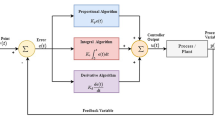Abstract
This paper presents a new data-driven model of length-pressure hysteresis of pneumatic artificial muscles (PAMs) based on Gaussian mixture models (GMMs). By ignoring the high-order dynamics, the hysteresis of PAMs is modeled as a first-order nonlinear dynamical system based on GMMs, and inversion of the model is subsequently derived. Several verification experiments are conducted. Firstly, parameters of the model are identified under low-frequency triangle-wave pressure excitations. Then, pressure signals with different amplitudes, shapes and frequencies are applied to the PAM to test the prediction performance of the model. The proposed model shows advantages in identification efficiency and prediction precision compared with a generalized Prandtl-Ishlinskii (GPI) model and a modified generalized Prandtl-Ishlinskii (MGPI) model. Finally, the effectiveness of the inverse model is demonstrated by implementing the feedforward hysteresis compensation in trajectory tracking experiments.
Similar content being viewed by others
References
Bogue R. Artificial muscles and soft gripping: A review of technologies and applications. Industrial Robot, 2012, 39: 535–540
Li M, Kang R, Branson D T, et al. Model-free control for continuum robots based on an adaptive Kalman filter. IEEE/ASME Trans Mechatron, 2018, 23: 286–297
Godage I S, Medrano-Cerda G A, Branson D T, et al. Dynamics for variable length multisection continuum arms. Int J Robot Res, 2016, 35: 695–722
Shin D, Yeh X, Khatib O. A new hybrid actuation scheme with artificial pneumatic muscles and a magnetic particle brake for safe human-robot collaboration. Int J Robot Res, 2014, 33: 507–518
Shin D, Sardellitti I, Park Y L, et al. Design and control of a bioinspired human-friendly robot. Int J Robot Res, 2010, 29: 571–584
Zhu L, Shi X, Chen Z, et al. Adaptive servomechanism of pneumatic muscle actuators with uncertainties. IEEE Trans Ind Electron, 2017, 64: 3329–3337
Huang J, Cao Y, Xiong C, et al. An echo state Gaussian process-based nonlinear model predictive control for pneumatic muscle actuators. IEEE Trans Automat Sci Eng, 2018, 1–14
Xie S L, Liu H T, Mei J P, et al. Modeling and compensation of asymmetric hysteresis for pneumatic artificial muscles with a modified generalized Prandtl-Ishlinskii model. Mechatronics, 2018, 52: 49–57
Xie S, Mei J, Liu H, et al. Hysteresis modeling and trajectory tracking control of the pneumatic muscle actuator using modified Prandtl-Ishlinskii model. Mech Mach Theoy, 2018, 120: 213–224
Lin C J, Lin C R, Yu S K, et al. Hysteresis modeling and tracking control for a dual pneumatic artificial muscle system using Prandtl-Ishlinskii model. Mechatronics, 2015, 28: 35–45
Gu G Y, Li C X, Zhu L M, et al. Modeling and identification of piezoelectric-actuated stages cascading hysteresis nonlinearity with linear dynamics. IEEE/ASME Trans Mechatron, 2016, 21: 1792–1797
Gu G Y, Zhu L M, Su C Y. Modeling and compensation of asymmetric hysteresis nonlinearity for piezoceramic actuators with a modified Prandtl-Ishlinskii model. IEEE Trans Ind Electron, 2014, 61: 1583–1595
Ko Y R, Hwang Y, Chae M, et al. Direct identification of generalized Prandtl-Ishlinskii model inversion for asymmetric hysteresis compensation. ISA Trans, 2017, 70: 209–218
Janaideh M A, Rakheja S, Su C Y. A generalized Prandtl-Ishlinskii model for characterizing the hysteresis and saturation nonlinearities of smart actuators. Smart Mater Struct, 2009, 18: 045001
Wang Y F, Xu R, Zhou M L. Prandtl-Ishlinskii modeling for giant magnetostrictive actuator based on internal time-delay recurrent neural network. IEEE Trans Magn, 2018, 54: 1–4
Ismail M, Ikhouane F, Rodellar J. The hysteresis Bouc-Wen model, a survey. Arch Comput Methods Eng, 2009, 16: 161–188
Zhu W, Wang D. Non-symmetrical Bouc-Wen model for piezoelectric ceramic actuators. Sens Actuat A-Phys, 2012, 181: 51–60
Martins S A M, Aguirre L A. Sufficient conditions for rate-independent hysteresis in autoregressive identified models. Mech Syst Signal Proc, 2016, 75: 607–617
Chen P, Bai X X, Qian L J, et al. An approach for hysteresis modeling based on shape function and memory mechanism. IEEE/ASME Trans Mechatron, 2018, 23: 1270–1278
Tan X B, Baras J S. Adaptive identification and control of hysteresis in smart materials. IEEE Trans Automat Contr, 2005, 50: 827–839
Nguyen P B, Choi S B, Song B K. Development of a novel diagonalweighted Preisach model for rate-independent hysteresis. Proc Inst Mech Eng C-J Mech Eng Sci, 2017, 231: 961–976
Ravichandar H C, Salehi I, Baillie B P, et al. Learning stable nonlinear dynamical systems with external inputs using Gaussian mixture models. In: Proceedings of the 2018 Annual American Control Conference (ACC 2018). Milwaukee: WI, 2018. 4825–4830
Salehian S S M, Khoramshahi M, Billard A. A dynamical system approach for softly catching a flying object: Theory and experiment. IEEE Trans Robot, 2016, 32: 462–471
24 Khansari-Zadeh S M, Billard A. Learning stable nonlinear dynamical systems with Gaussian mixture models. IEEE Trans Robot, 2011, 27: 943–957
Gribovskaya E, Khansari- Zadeh S M, Billard A. Learning non-linear multivariate dynamics of motion in robotic manipulators. Int J Robotics Res, 2011, 30: 80–117
Hu H Y, Wang Z H. On hysteresis and retardation (in Chinese). Chin J Theor Appl Mech, 2010, 42: 740–746
Covões T F, Hruschka E R. Unsupervised learning of Gaussian mixture models: Evolutionary create and eliminate for expectation maximization algorithm. In: Proceedings of the 2013 IEEE Congress on Evolutionary Computation (CEC 2013). Cancun, 2013. 3206–3213
Farrokh M. Hysteresis simulation using least-squares support vector machine. J Eng Mech, 2018, 144: 04018084
Li Y F, Chen M N, Lu X D, et al. Research on optimized GA-SVM vehicle speed prediction model based on driver-vehicle-road-traffic system. Sci China Tech Sci, 2018, 61: 782–790
Ang K H, Chong G, Yun Li G. PID control system analysis, design, and technology. IEEE Trans Contr Syst Technol, 2005, 13: 559–576
Yao S, Li H, Zeng L, et al. Vision-based adaptive control of a 3-RRR parallel positioning system. Sci China Tech Sci, 2018, 61: 1253–1264
Author information
Authors and Affiliations
Corresponding author
Rights and permissions
About this article
Cite this article
Xu, J., Xiao, M. & Ding, Y. Modeling and compensation of hysteresis for pneumatic artificial muscles based on Gaussian mixture models. Sci. China Technol. Sci. 62, 1094–1102 (2019). https://doi.org/10.1007/s11431-018-9488-1
Received:
Accepted:
Published:
Issue Date:
DOI: https://doi.org/10.1007/s11431-018-9488-1




